Twenty things that surprise first-time visitors to Chicago
More than the home of the Bulls, the Cubs and the deep-dish pizza, the Windy City has plenty of quirks – and delights – to uncover for first-timers, from the city’s pioneering design to its vibrant arts scene and so much more.
It’s as flat as a pancake
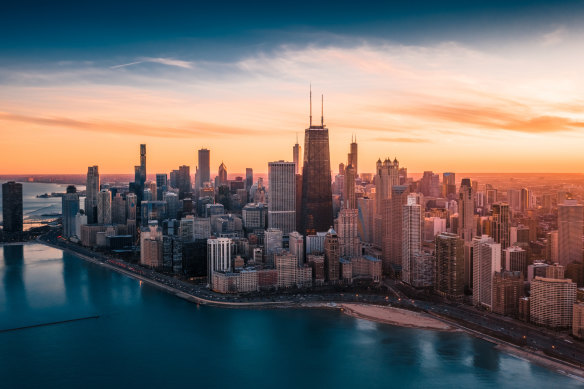
Chicago is flat, which makes it perfect for cycling.Credit: Getty Images
In the heart of the Midwest and fabled prairie-land, Chicago is one of the flattest cities in America, making it a great city for cycling. Take in the breathtaking Michigan Lake shoreline along the Lakefront Trail and then head into the city via its parklands. Bike lanes are plentiful and motorists considerate. Self-tour with the bike-sharing scheme (Divvy) or Bobby’s Bike Tours run a fun “Bikes, Bites and Brews” ride that combines food, history and sightseeing during a four-hour trip. See bobbysbikehike.com
It was nearly destroyed by fire
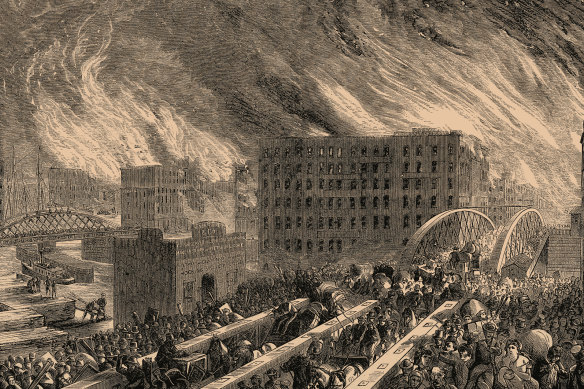
Illustration of the Great Chicago Fire of 1871.Credit: Getty Images
The 1871 fire that almost destroyed Chicago is the most famous in US history and is embedded in the fabric of society – you’ll hear it mentioned almost everywhere. The fire was rumoured to have started in a woman’s barn and quickly burned through the city’s predominantly lumber buildings, destroying more than 117 kilometres of roads, 190 kilometres of pavement, 2000 lampposts, 17,500 buildings and blazing through $US222 million in property value, which was about a third of the city’s valuation.
The posh end of town was created from the fire’s rubble
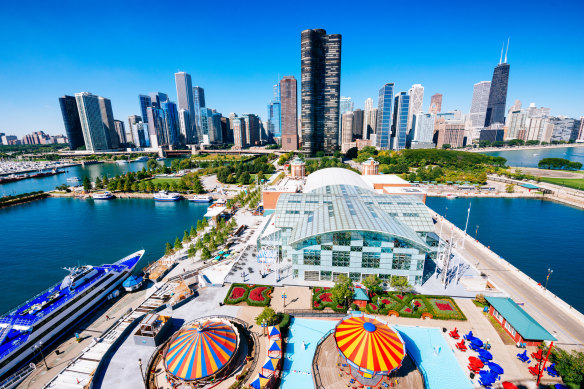
Navy Pier sits on debris from Chicago’s famous fire.Credit: Getty Images
Rubble from the fire was dumped into Lake Michigan, creating an artificial land mass that one opportunistic individual illegally claimed as his own and sold lots to residents. It’s now home to the Navy Pier and Streeterville, one of the most expensive neighbourhoods in Chicago. It is often said the city’s “front garden” was also created from the excessive debris, which includes Grant Park and Millennial Park, home to “The Bean”.
Chicago has some of the world’s best architecture
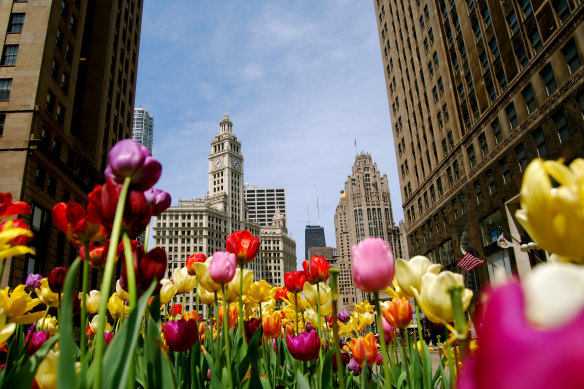
The iconic Wrigley Building built by chewing gum tycoon William Wrigley Jnr.Credit: Getty Images
When the city started to rebuild after the fire, the quintupled population included a flurry of architects who pushed the boundaries of modern design, with the collective aim of wanting to build one of the most memorable skylines in the world. The city has the second-tallest skyline in the US after New York City. The best way to view the architecture is via a boat tour run by the Chicago Architecture Centre.
The Chicago River flows backwards
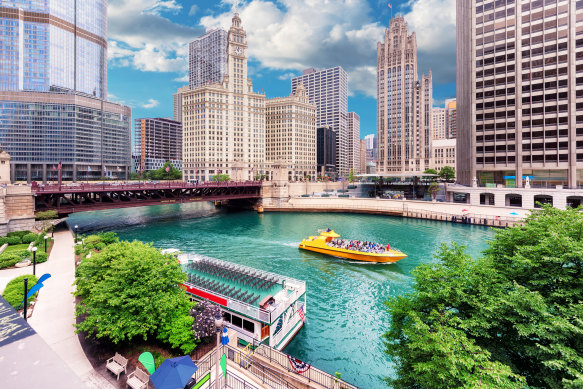
Picturesque Chicago River, once heavily polluted.Credit: Getty Images
It’s hard to picture now, but once the river was so foul and thick with crusted sewage that a chicken could run from one side to the other, and the putrid waters flowed straight into Lake Michigan – which also supplied the city’s water. Eventually, the river flow was reversed through the construction of a canal, channelling the waters into the Mississippi instead and creating the world’s only river that flows backwards. The Wrigley Building built by chewing gum tycoon William Wrigley Jnr in 1921 set off a development boom around the Chicago River. Now, the “urban canyon” it created is a treasured part of the city and people can walk, cycle or cruise its length.
The world’s first skyscraper was built in Chicago
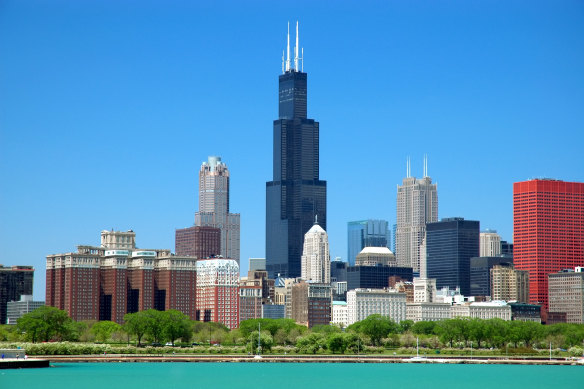
Willis Tower was the world’s first skyscraper.Credit: Getty Images
When the Willis Tower was completed in 1973, it was the tallest building in the world. It still towers above the rest of the city, instantly recognisable by its famous antennas that add almost 91 metres of height to its frame. Visitors can test their mettle on Skydeck’s “The Ledge” – a series of glass balconies that overlook the city from its 103rd floor, 412 metres in the air. And if that isn’t a big enough thrill, head to 875 N. Michigan Avenue and experience ‘Tilt’ at 360 Chicago – a glass wall that tips riders over the edge of the city from the 94th floor. On a clear day, you can see up to 90 kilometres away and take in all four surrounding states.
Lake Michigan is one of the world’s largest lakes
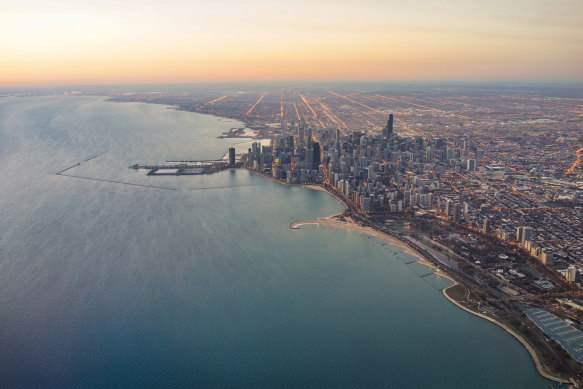
Lake Michigan is indescribably huge.Credit: iStock
Chicago’s other icon, Lake Michigan, is so large it looks more like an inland sea, and is pumped for the city’s water supply by stations that sit on the horizon like big circus tents. It’s the fourth-largest lake in the world (by surface area) and no one knows how deep it is – there’s even an area dubbed the “Michigan Triangle” where planes and ships have disappeared. During Chicago’s freezing winters, a skin-like layer of ice forms over the lake which is definitely not walkable.
Beaches aren’t really beaches
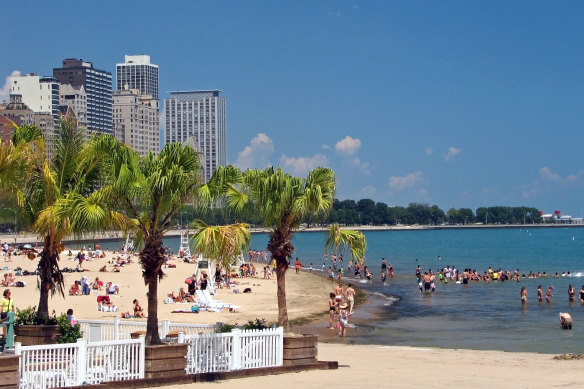
You won’t see the sunset from Chicago’s lakeside “beaches”.Credit: iStock
The 45-kilometre shoreline around Lake Michigan is entirely man-made and its sand is dredged from the bottom of the lake and other areas of Illinois to create the 24 “beaches”. Just as at regular beaches, there are plenty of activities to enjoy – from watersports to swimming, volleyball, dining and live music. Swimming is allowed only between 6am and 11pm, when lifeguards are on duty.
The only raised railway in the US
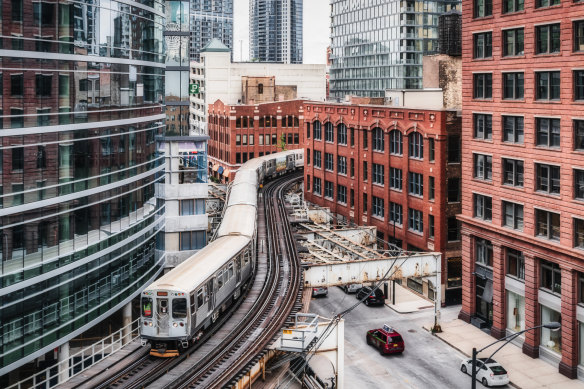
Many of Chicago’s trains are on raised lines.Credit: Getty Images
While other cities chose to build subway systems, Chicago kept their elevated railways as there were concerns the city’s swampy soil may not be suited to an underground railway – and they were much cheaper to build. Now, there are 360 kilometres of combined subway and elevated rail tracks that transport more than a million riders a day.
It’s not called the ‘Windy City’ because of the weather
Chicago did not get its nickname because it’s windy (even though it is most definitely is). The nickname arose from a newspaper reporter who called out most of the Chicago politicians for being profit-centric and “full of hot air”.
It’s famous for comedy, particularly improv
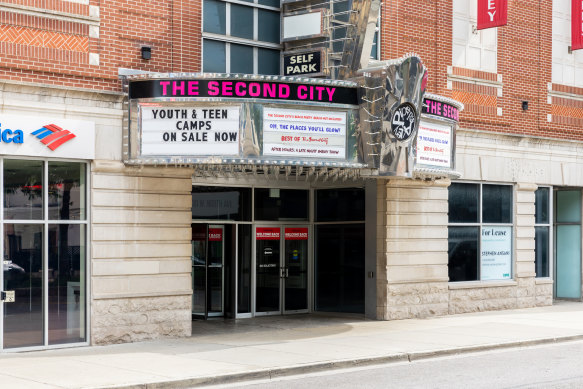
Second City, founded in 1959, was the starting point for many award-winning comedians.Credit: Getty Images
Based on games, comedic improvisation got its start in Chicago at Second City in 1959, and this intimate theatre is a must-visit for great improv. Some of the best comedians in the world have performed here, including Saturday Night Live alumni (Tina Fey, Amy Poehler, Bill Murray, Eugene Levy). There is a multitude of shows to choose from – buckle in for some of the best comedy of your life. See secondcity.com
The fast food is elite
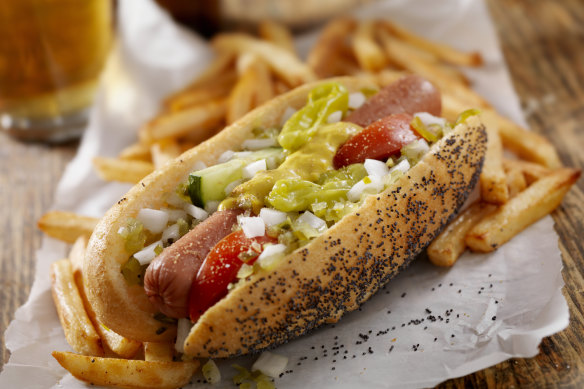
The Chicago hot dog is “dragged through the garden” and tomato sauce is a big no-no.Credit: Getty Images
Chicago’s iconic deep-dish pizza is delicious, and its hot dogs converted this bad vegetarian into a beefeater. Described as “dragged-through-the-garden-style”, toppings include diced onions, tomatoes, mustard, celery salt, dill pickle and green sweet pickle relish on a poppy seed bun. How did it come about? Jewish immigrants created the all-beef sausage, while Polish were responsible for the poppy seed bun. It became popular during the Great Depression, and they piled on the vegetables for a more well-rounded meal. Try it at retro diner-style Wrigleysville Dogs, near Wrigley Stadium.
Its baseball team has some famous fans
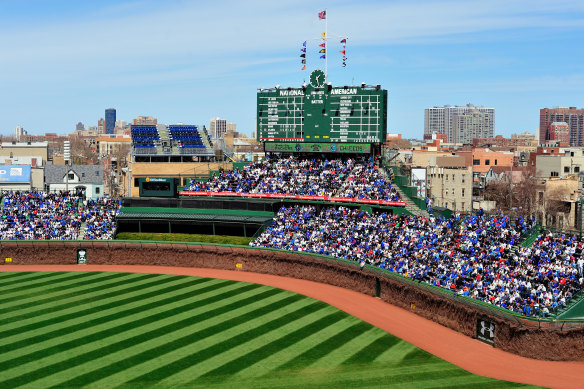
Wrigley Field is Chicago’s historic baseball stadium.Credit: Alamy Stock Photo
Chicago’s baseball stadium Wrigley Field is the second oldest behind Boston’s Fenway Park. Built in 1914, it still retains its retro feel with the original scoreboard intact. Once the game starts, be prepared to be swept into the thrall with enthusiastic crowds, music played with every point, and player and game stats beamed across the field. Wrigley was named after the chewing gum magnate who was an early investor in the team, and Bill Murray is the club’s most legendary fan.
Eat at the old meatpacking district
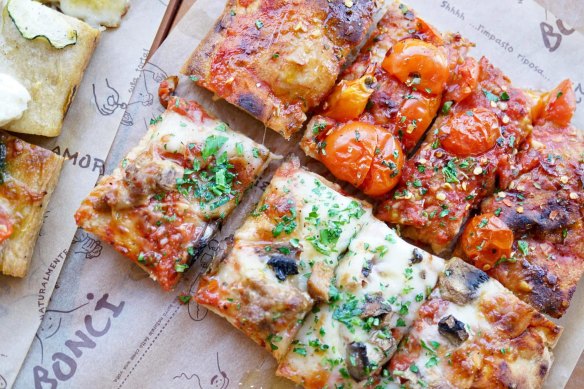
For a taste of Rome, head to Bonci Pizza in West Loop.
The old meatpacking district is now “restaurant row” and one of the city’s best places to eat. Take a food tour with a retired chef through the West Loop, one of the fastest developing areas of Chicago with an abundance of new eateries. This area is home to the Time Out Market, traditional taverna-style Italian, a heavy-metal burger and beer bar, and my personal favourite, Bonci Pizza, where the “Michelangelo of pizza” Gabriele Bonci has recreated his original Roman shop, selling innovative pizza slices by weight. Try them all with Chicago Food Tours.
Ferris took more than one day off
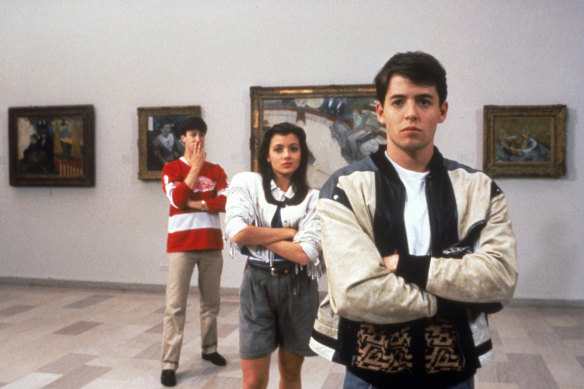
It is unlikely Ferris and his friends had such an eventful day off, pictured here at Art Institute.Credit: Alamy
Cult ’80s John Hughes movie Ferris Bueller’s Day Off was filmed in Chicago, taking in some of the city’s best loved sights, including a baseball game at Wrigley Field, 360-degree views of Chicago from Sears Tower (the spot where the stars stood is marked), a fancy lunch and a stop at the famed Art Institute. Many internet sleuths have concluded that although Ferris claimed “life moved pretty fast”, there is no way the three characters could have covered all that ground and have arrived home by 6pm as they did in the movie. Fun fact: local John Hughes set the Bueller house in a made-up suburb called Shermer, based on his hometown of Northbrook.
It’s home to the biggest Starbucks in the world
Haters gonna hate, but there’s no denying the popularity of Starbucks in Chicago – and the world’s largest is on the Magnificent Mile. There are plenty of reasons to visit, including a whole floor dedicated to cold brew and rare beans. There’s also a bakery, restaurant, cocktail bar and rooftop terrace.
The only place acceptable for travellers to eat at McDonald’s
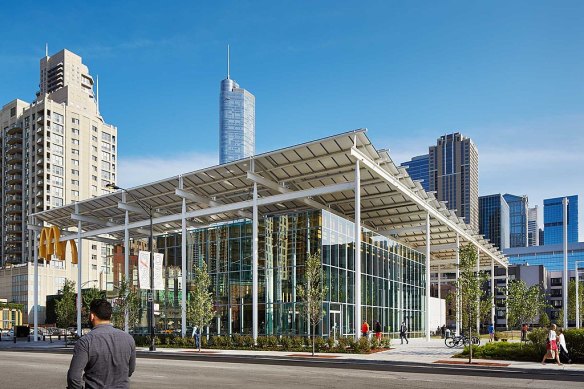
In Chicago, even McDonald’s impresses with the architecture of its flagship store.Credit: Wikimedia Commons
It may be a cardinal sin everywhere else, but in Chicago, it’s OK to eat at McDonald’s. That’s because their global headquarters located in the hip West Loop has a rotating menu of lucrative items from Maccy D restaurants all over the world. Also worth a look is their flagship restaurant on N Clark St, an impressive glass structure with a pro-green build that includes a solar pergola, mini-arboretum and vertical gardens.
Chicago is a serious food town, too
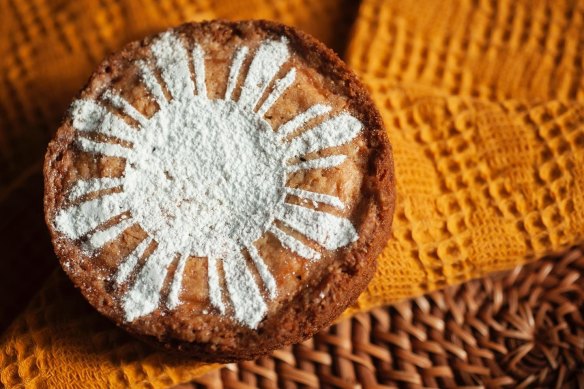
Kasama’s pastries are elite.Credit: Kasama
There’s a reason why smash hit TV series The Bear shone a spotlight on the food in Chicago; that’s because it is seriously good. Try gleaming Gibson’s Italia, a new restaurant overlooking the river from iconic steakhouse proprietors of the same name. 2023 also brought a smattering of new chic-but-casual restaurants such as The Evie, where you can dine on old-school prawn cocktail with designer martinis, and Ummo, a swanky Italian diner decorated with posters of musical icons and a second storey that turns into a nightspot after 10pm. If you’re going to choose one restaurant, make it Kisama – by morning, it’s a French-style bakery with Filipino flavours; by night, it does Chicago’s only Filipino tasting menu. See kasamachicago.com
Locals were horrified by The Bear’s take on deep-dish
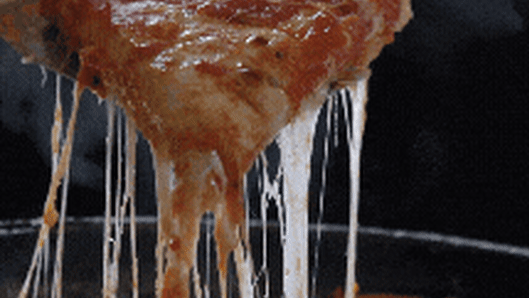
Chicago’s iconic deep-dish pizza should not be messed with.
An outcry followed two-star Michelin restaurant Ever’s dismemberment of the local favourite from iconic deep-dish purveyor Pequod. Its famous pie was sliced with a cookie cutter and turned into a bagel-shaped pastry smeared with tomato, garnished with leaves of microbasil.
Its art is free
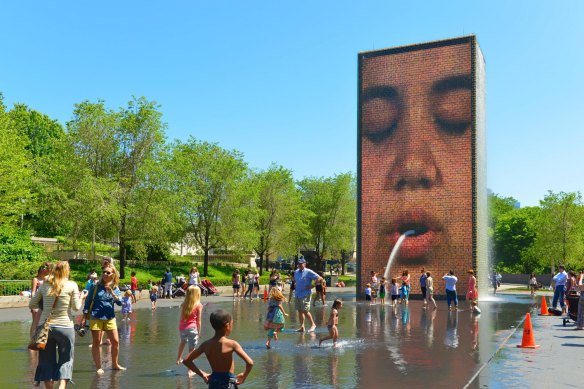
Chicago’s “Spitting Fountains” in Millennium Park.Credit: Alamy
Chicago loves its arts just as much as New York City, and plenty of its public art is free such as Cloud Gate (AKA “The Bean”) and Crown Fountain (AKA “Spitting Fountains”) in lakefront Millennium Park. There are nightly light installations at the Mart, a building so large it has its own zip code. Serious art fanciers can visit the world-renowned Art Institute, and there’s the playful interactive art museum WNDR that features an Infinity Mirror Room by Japanese artist Yayoi Kusama. Live music is also huge, with plenty of summer music festivals such as Lollapalooza and Riot Fest, which in 2023 was headlined by The Cure, Death Cab for Cutie, The Postal Service and Foo Fighters.
The writer was a guest of Air New Zealand and Choose Chicago.
Sign up for the Traveller Deals newsletter
Get exclusive travel deals delivered straight to your inbox. Sign up now.